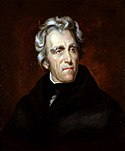Roger Brooke Taney
 | |
| Data i miejsce urodzenia | 17 marca 1777 |
|---|---|
| Data śmierci | 12 października 1864 |
| 5. prezes Sądu Najwyższego Stanów Zjednoczonych | |
| Okres | od 28 marca 1836 |
| Poprzednik | |
| Następca | |
| 12. sekretarz skarbu Stanów Zjednoczonych | |
| Okres | od 23 września 1833 |
| Poprzednik | William John Duane |
| Następca | |
| 11. prokurator generalny Stanów Zjednoczonych | |
| Okres | od 20 lipca 1831 |
| Poprzednik | John Macpherson Berrien |
| Następca | |
Roger Brooke Taney (ur. 17 marca 1777 w hrabstwie Calvert stanu Maryland, zm. 12 października 1864 w Waszyngtonie) – amerykański prawnik i polityk. Pełnił między innymi funkcje prokuratora generalnego, sekretarza skarbu i prezesa Sądu Najwyższego Stanów Zjednoczonych.
Życiorys
Roger Brooke Taney urodził się 17 marca 1777 roku w hrabstwie Calvert stanu Maryland. W 1795 roku ukończył Dickinson College. Później studiował prawo i w 1799 roku został przyjęty do palestry.
Taney zamieszkał w mieście Frederick i przez pięć lat zasiadał w stanowym senacie Maryland. W 1823 roku przeprowadził się do Baltimore i w 1827 roku został prokuratorem generalnym stanu Maryland.
W 1831 roku prezydent Andrew Jackson mianował go prokuratorem generalnym Stanów Zjednoczonych w swoim gabinecie. Funkcję tę sprawował do 1833 roku, gdy Jackson mianował go sekretarzem skarbu. Jednak jego kandydatura nie uzyskała akceptacji Senatu USA. W 1835 roku prezydent Jackson mianował go prezesem Sądu Najwyższego Stanów Zjednoczonych. Tym razem senat zaakceptował jego nominację i Taney pełnił funkcję prezesa Sądu Najwyższego aż do śmierci 12 października 1864 roku. Zmarł w Waszyngtonie w wieku 87 lat.
Jego kadencja na stanowisku prezesa Sądu Najwyższego trwała 28 lat i była drugą pod względem długości w historii tej instytucji, po jego poprzedniku, Johnie Marshallu.
Linki zewnętrzne
- Biografia. supremecourthistory.org. [zarchiwizowane z tego adresu (2011-05-22)]. The Supreme Court Historical Society (ang.)
- Biografia Departament Skarbu Stanów Zjednoczonych (ang.)
- Biografia Departament Sprawiedliwości Stanów Zjednoczonych (ang.)
Media użyte na tej stronie
Logo of the United States White House, especially in conjunction with offices like the Chief of Staff and Press Secretary.
Andrew Jackson - 7th President of the United States (1829–1837)
Signature of Roger B. Taney.
Seal of the United States Department of Justice.
The origins of the seal are unknown; it was first used in the 19th century as the seal for the Office of the Attorney General (prior to the formation of the Department of Justice) but the exact date is unknown. Even the translation of the Latin motto is murky, a matter of debate between Latin scholars. The Department's currently accepted translation is who prosecutes on behalf of Lady Justice, referring to the Attorney General. The motto is an allusion to the wording of the writ in a qui tam action: qui tam pro domino rege quam pro se ipso sequitur ("he who sues on behalf of our lord the King as well as for himself." The current-day seal dates from 1934, when some (though not all) of the heraldic mistakes on the original were corrected. More information here.










